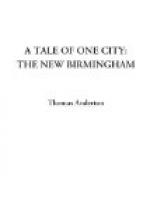The only little old-date shop in the heart of Birmingham that, till recently, rivalled the “silver-smithy” I have described in High Street, was a saddler’s at the top of New Street, which nestled under the shadow of Christ Church. It had the old-style small bow windows, the low roof, and the circumscribed area of old-fashioned shops. The ancient saddler who formerly tenanted it had not enough space to crack a whip, let alone swing a cat in. In past days, however, business was carried on under “limited” principles, but chiefly limited as to extent and space.
When walking about Birmingham, archaeological observers should look up if they wish to see and note any traces of age and antiquity. The lower portions of old premises have often been so enlarged and modernized that they give no sign of the real date of the buildings. In Bull Street, for instance, there are narrow old style windows that are very suggestive of a bygone day. But these are becoming few and far between, and will doubtless soon be seen no more.
Old-fashioned shops naturally suggest new and old-style shopkeeping. In a recent chapter I alluded to some long-established trading houses in Birmingham that within certain limits carry on their trade in a manner that differs from the very modern and obtrusively pressing fashion which is so much the custom of the day. Something of the same kind may be said of shops, as I generally remarked in my earlier observations. But to descend more into detail, there are still among its at any rate a limited number of shopkeepers who like to do their business on good, safe, and steady lines, and keep together a nice respectable connection by upholding the dependable quality of their wares. Some of these shopkeepers do not make much of an outward show, but I have reason to know that many of them in a quiet undemonstrative manner do a snug and prosperous trade without fuss or display.
I will just briefly particularize. Opposite King Edward’s School in New Street is a quiet, unostentatious-looking tobacconist’s shop. The window plate bears the name of Evans, and in the window is a modest show of smoking wares and materials. If you step inside the shop, it is comparatively calm and quiet. You do not see young men sitting about smoking, chatting, and joking with girls across the counter. There is no constant succession of customers coming in and out and buying their ounces and half ounces of “Returns,” “Bird’s Eye,” “Shag,” and “Old Virginia.” Yet an evident perfume of tobacco and prosperity seems to pervade the shop, but no sign of the Tom, Dick, and Henry sort of trade that is done by more ostentatious modern traders. It is, I believe, a case of half a century’s trading in good tobacco stuffs having established a connection among those who like good tobacco, will pay a proper price for it, and deal where they can get it.




